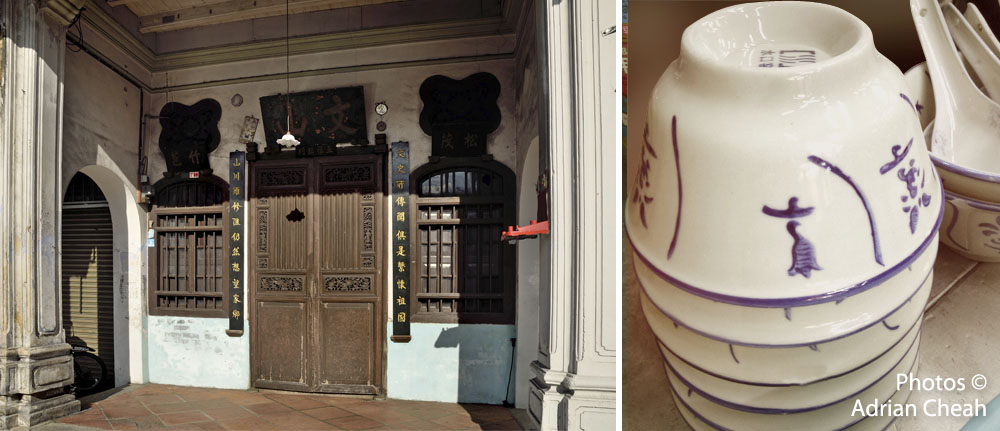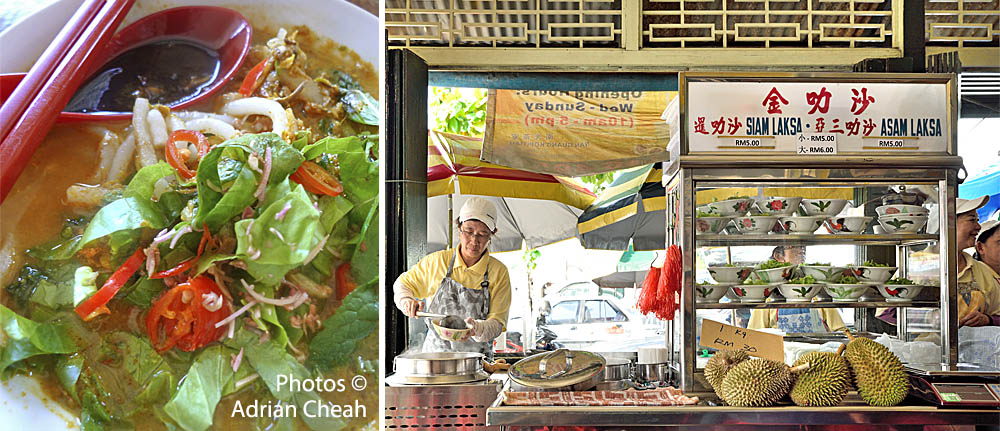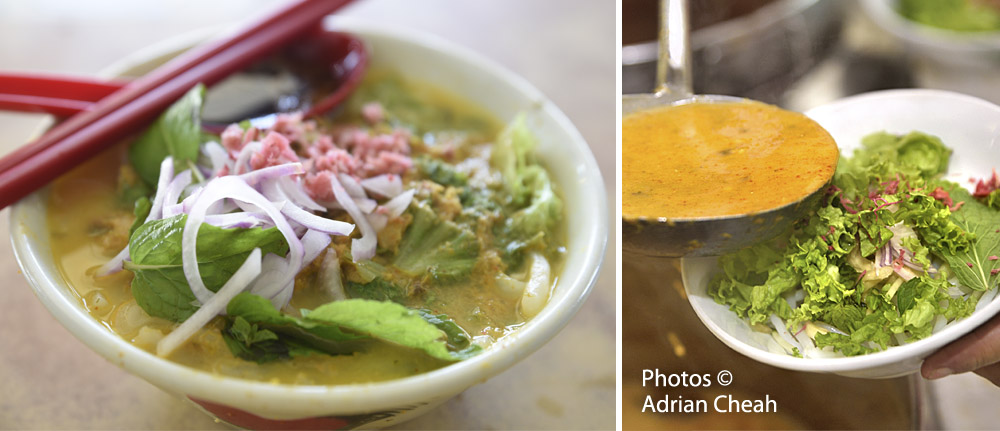The best laksa in Balik Pulau

Penang laksa is extremely popular, especially among locals for its wonderful balance of spicy, sweet and sour flavours. This is strictly a hawker treat, as one is unlikely to find great laksa in a fancy restaurant.
Laksa is basically made out of coarse rice noodles in a sour fish in assam-based gravy, plus a robust combo of onions, sliced chilli, cucumber, pineapple and bunga kantan (ginger buds), topped with a swirl of thick, black shrimp paste sauce. There is also an alternative variant called laksa lemak, which has a coconut milk-based soup instead of assam (tamarind).
Where do you go for the best laksa in Penang?
Undoubtedly, the Ayer Itam (the stall next to the market) and Balik Pulau (at Kim Seng Kopitiam) would be two popular places most Penangites would recommend. Here, I will only focus on the latter.

Ms Ann Martin runs the laksa stall at Kim Seng Kopitiam. She has kept faithful to the flavours perpetuated by Mrs Ewe Chooi Guan, maintaining both the quality and taste. By the way, Mrs Ewe's maiden name is Chew Gaik Kim. Her name Kim must have given genesis to the frequently used name of "Kim laksa".
Mr and Mrs Ewe owned the stall at the corner of Nan Guang coffeeshop, 67 Main Road (next to the old, now demolished market) for over three decades. Mrs Ewe was believed to have honed her skill in cooking assam laksa, learning from the original laksa maker in the village at 100 Main Road.

The Khoos of 100 Main Road had a good run and monopolised the laksa business in the village. The household supplied all the ingredients – including the homemade rice noodles "balls" – to various outlets in the village. Ms Josephine Choo can still vividly recall in the 1960s (her growing up years), she and a neighbour slurping up a bowl of asam laksa behind the market for a mere 10 cents (where you will get only one "ball" of laksa noodles). Back then, the little "laksa ua" (bowls) had a diameter of only four inches or so, thus, I would consider this a snack rather than a proper serving for the main meal. In the 1970s, when the grandmother of Mr Khoo Poh Swee passed away, that concluded a chapter in the laksa saga of the village, opening a new chapter for the Ewes.

Left photo: Mrs Ewe preparing a bowl of laksa. Courtesy of Chin Saik Yoon, 1998.
Maintaining great quality, the Ewe laksa stall grew in popularity and became a must-visit destination for all venturing into Balik Pulau. Business would start around lunch and rarely extending to teatime. When I was in Balik Pulau, savouring a bowl of Ms Ewe's laksa was a must. I adore the lemak version, an invention she introduced to the village. Nan Guang coffeeshop was eventually taken over by their youngest son.

When Mr and Mrs Ewe finally retired, the stall was “franchised” to Ann. She continued the laksa stall at Nan Guang for a few years before relocating to Kim Seng Kopitiam in the then, newly developed area of Botanica.CT. Loyal customers do not mind travelling a little, off the hustle and bustle of the village centre to enjoy Ann's laksa.

If it is your first time there, try both versions, the asam as well as the lemak options. If you are feeling adventurous, opt for the "half and half" mixture, savouring the best of both worlds. I love my serving with less noodles and lots of vegetables. The sweet onions, fragrant mint leaves and diced torched ginger buds perfume the laksa, making it a delightful encounter. Go early to avoid disappointment.
At Kim Seng Kopitiam, Ann's brother John mans the char koay teow stall. There are also other items to sample besides laksa at the premises.

Although Ann has since relocated, there is yet another new stall (Kim Laksa) operating at Nan Guang, run by Christine. Right opposite the road, there are other stalls selling laksa as well. To each its own I say. Try all and decide who serves the best laksa in the village. My personal preference is still Ann's who must have obtained some trade secrets from Mrs Ewe. She had the right balance of flavours and serves a generous portion of flesh in the gravy. Fresh ingredients for laksa are aplenty in the village – famous Chop Kim Hoa belacan from Pulau Betong and a fresh supply of fish from nearby fisherfolk.
Coincidentally, my mum's surname is also Martin and Ann is somehow related to us. My maternal grandfather, Louis Michael Martin, had brothers and one of them had Ann and John as grandchildren.
---------------------------------------------------------
Trivia: the origin of Laksa

The origin of the name “laksa” has given rise to a few theories. In Hindi/Persian “lakhshah” refers to a type of vermicelli. “Lakhsah” could also have derived from the Sanskrit "laksha" meaning “one hundred thousand”, referencing the strands of noodles. In Chinese "la sha" (辣沙) literally means “spicy sand”, connoting the gritty texture of the laksa gravy of ground fish. In Hokkien the words for “rubbish” are ”lup sup” – this possibly a reference to the murky and gritty appearance of the gravy or the pungent aroma from the shrimp paste used in the dish.
I share the belief of some that laksa is a dish born from intermarriages throughout Southeast Asia when Chinese merchants ventured along the spice route to trade. Some from the Fujian province settled down in the Straits Settlements, creating the Peranakan culture. The creative womenfolk experimented and invented a host of culinary delights, synonymous with their heritage. Their liberal use of local ingredients, herbs and spices in their kitchen gave birth to colourful Nyonya kuihs and memorable dishes, laksa being one of them. From all over Southeast Asia, there is such an enormous variety of laksa.

Penang has elevated its two – asam laksa and laksa lemak – to great heights in the world's gastronomy arena. In 2019, Penang Asam Laksa Ranked 7th in CNN's World's 50 best foods. Even the late legendary Anthony Bourdain lauded it as among the best dishes he ever tasted. Imagine, he almost said yummy.
While we might never know for sure the exact origin of laksa, I am happy that it is widely recognised throughout the Southeast Asian region with so many variations. So much to sample, so little time.
---------------------------------------------------------
Written and photographed by Adrian Cheah © All rights reserved
19 August 2020
--------------------------------------------------------
Kim Seng Kopitiam, 20 Jalan Sungai Air Putih, Bandar Baru Air Putih (Botanica. CT), Balik Pulau, 11000 Penang
T: +6012 428 6235
Opens: 11 am to 5 pm. Closed on alternate Mondays and every Tuesday.